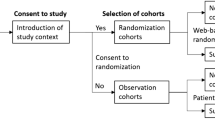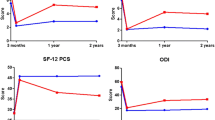Abstract
Background
Although previous studies have illustrated improvements in surgical cohorts for patients with intervertebral disc herniation, there are limited data on predictors of long-term outcomes comparing surgical and nonsurgical outcomes.
Questions/purposes
We assessed outcomes of operative and nonoperative treatment for patients with intervertebral disc herniation and symptomatic radiculopathy at 8 years from the Spine Patient Outcomes Research Trial. We specifically examined subgroups to determine whether certain populations had a better long-term outcome with surgery or nonoperative treatment.
Methods
Patients with symptomatic lumbar radiculopathy for at least 6 weeks associated with nerve root irritation or neurologic deficit on examination and a confirmed disc herniation on cross-sectional imaging were enrolled at 13 different clinical sites. Patients consenting to participate in the randomized cohort were assigned to surgical or nonoperative treatment using variable permuted block randomization stratified by site. Those who declined randomization entered the observational cohort group based on treatment preference but were otherwise treated and followed identically to the randomized cohort. Of those in the randomized cohort, 309 of 501 (62%) provided 8-year data and in the observational group 469 of 743 (63%). Patients were treated with either surgical discectomy or usual nonoperative care. By 8 years, only 148 of 245 (60%) of those randomized to surgery had undergone surgery, whereas 122 of 256 (48%) of those randomized to nonoperative treatment had undergone surgery. The primary outcome measures were SF-36 bodily pain, SF-36 physical function, and Oswestry Disability Index collected at 6 weeks, 3 months, 6 months, 12 months, and then annually. Further analysis studied the following factors to determine if any were predictive of long-term outcomes: sex, herniation location, depression, smoking, work status, other joint problems, herniation level, herniation type, and duration of symptoms.
Results
The intent-to-treat analysis of the randomized cohort at 8 years showed no difference between surgical and nonoperative treatment for the primary outcome measures. Secondary outcome measures of sciatica bothersomeness, leg pain, satisfaction with symptoms, and self-rated improvement showed greater improvement in the group randomized to surgery despite high levels of crossover. The as-treated analysis of the combined randomized and observational cohorts, adjusted for potential confounders, showed advantages for surgery for all primary outcome measures; however, this has the potential for confounding from other unrecognized variables. Smokers and patients with depression or comorbid joint problems had worse functional outcomes overall (with surgery and nonoperative care) but similar surgical treatment effects. Patients with sequestered fragments, symptom duration greater than 6 months, those with higher levels of low back pain, or who were neither working nor disabled at baseline showed greater surgical treatment effects.
Conclusions
The intent-to-treat analysis, which is complicated by high rates of crossover, showed no difference over 8 years for primary outcomes of overall pain, physical function, and back-related disability but did show small advantages for secondary outcomes of sciatica bothersomeness, satisfaction with symptoms, and self-rated improvement. Subgroup analyses identified those groups with sequestered fragments on MRI, higher levels of baseline back pain accompanying radiculopathy, a longer duration of symptoms, and those who were neither working nor disabled at baseline with a greater relative advantage from surgery at 8 years.
Level of Evidence
Level II, therapeutic study. See Instructions for Authors for a complete description of levels of evidence.



Similar content being viewed by others
References
Akagi R, Aoki Y, Ikeda Y, Nakajima F, Ohtori S, Takahashi K, Yamagata M. Comparison of early and late surgical intervention for lumbar disc herniation: is earlier better? J Orthop Sci. 2010;15:294–298.
Akmal M, Kesani A, Anand B, Singh A, Wiseman M, Goodship A. Effect of nicotine on spinal disc cells: a cellular mechanism for disc degeneration. Spine (Phila Pa 1976). 2004;29:568–575.
Atlas SJ, Keller RB, Wu YA, Deyo RA, Singer DE. Long-term outcomes of surgical and nonsurgical management of sciatica secondary to a lumbar disc herniation: 10 year results from the Maine Lumbar Spine Study. Spine (Phila Pa 1976). 2005;30:927–935.
Atlas SJ, Tosteson TD, Blood EA, Skinner JS, Pransky GS, Weinstein JN. The impact of Workers’ Compensation on outcomes of surgical and nonoperative therapy for patients with a lumbar disc herniation: SPORT. Spine (Phila Pa 1976). 2010;35:89–97.
Battie MC, Videman T, Kaprio J, Gibbons LE, Gill K, Manninen H, Saarela J, Peltonen L. The Twin Spine Study: contributions to a changing view of disc degeneration. Spine J. 2009;9:47–59.
Behrend C, Prasarn M, Coyne E, Horodyski M, Wright J, Rechtine GR. Smoking cessation related to improved patient-reported pain scores following spinal care. J Bone Joint Surg Am. 2012;94:2161–2166.
Birkmeyer NJ, Weinstein JN, Tosteson AN, Tosteson TD, Skinner JS, Lurie JD, Deyo R, Wennberg JE. Design of the Spine Patient Outcomes Research Trial (SPORT). Spine (Phila Pa 1976). 2002;27:1361–1372.
Chaichana KL, Mukherjee D, Adogwa O, Cheng JS, McGirt MJ. Correlation of preoperative depression and somatic perception scales with postoperative disability and quality of life after lumbar discectomy. J Neurosurg Spine. 2011;14:261–267.
Chen HN, Tsai YF. A predictive model for disability in patients with lumbar disc herniation. J Orthop Sci. 2013;18:220–229.
Fitzmaurice G. Adjusting for confounding. Nutrition. 2004;20:594–596.
Folman Y, Shabat S, Catz A, Gepstein R. Late results of surgery for herniated lumbar disk as related to duration of preoperative symptoms and type of herniation. Surg Neurol. 2008;70:398–401; discussion 401–492.
Frymoyer JW. Back pain and sciatica. N Engl J Med. 1988;318:291–300.
Frymoyer JW. Lumbar disk disease: epidemiology. Instr Course Lect. 1992;41:217–223.
Frymoyer JW, Pope MH, Costanza MC, Rosen JC, Goggin JE, Wilder DG. Epidemiologic studies of low-back pain. Spine (Phila Pa 1976). 1980;5:419–423.
Gray DT, Deyo RA, Kreuter W, Mirza SK, Heagerty PJ, Comstock BA, Chan L. Population-based trends in volumes and rates of ambulatory lumbar spine surgery. Spine (Phila Pa 1976). 2006;31:1957–1963; discussion 1964.
Hall MJ, DeFrances CJ, Williams SN, Golosinskiy A, Schwartzman A. National hospital discharge survey: 2007 summary. Natl Health Stat Report. 2010;29:1–20.
Jansson KA, Nemeth G, Granath F, Jonsson B, Blomqvist P. Health-related quality of life in patients before and after surgery for a herniated lumbar disc. J Bone Joint Surg Br. 2005;87:959–964.
Lebow R, Parker SL, Adogwa O, Reig A, Cheng J, Bydon A, McGirt MJ. Microdiscectomy improves pain-associated depression, somatic anxiety, and mental well-being in patients with herniated lumbar disc. Neurosurgery. 2012;70:306–311; discussion 311.
Lurie JD, Faucett SC, Hanscom B, Tosteson TD, Ball PA, Abdu WA, Frymoyer JW, Weinstein JN. Lumbar discectomy outcomes vary by herniation level in the Spine Patient Outcomes Research Trial. J Bone Joint Surg Am. 2008;90:1811–1819.
Lurie JD, Tosteson TD, Tosteson AN, Zhao W, Morgan TS, Abdu WA, Herkowitz H, Weinstein JN. Surgical versus nonoperative treatment for lumbar disc herniation: eight-year results for the Spine Patient Outcomes Research Trial. Spine (Phila Pa 1976). 2014;39:3–16.
Pearson A, Lurie J, Tosteson T, Zhao W, Abdu W, Mirza S, Weinstein J. Who should have surgery for an intervertebral disc herniation? Comparative rffectiveness rvidence from the Spine Patient Outcomes Research Trial. Spine (Phila Pa 1976). 2012;37:140–149.
Pearson AM, Blood EA, Frymoyer JW, Herkowitz H, Abdu WA, Woodward R, Longley M, Emery SE, Lurie JD, Tosteson TD, Weinstein JN. Sport lumbar intervertebral disk herniation and back pain: does treatment, location, or morphology matter? Spine (Phila Pa 1976). 2008;33:428–435.
Peul WC, van Houwelingen HC, van den Hout WB, Brand R, Eekhof JA, Tans JT, Thomeer RT, Koes BW. Surgery versus prolonged conservative treatment for sciatica. N Engl J Med. 2007;356:2245–2256.
Sorlie A, Moholdt V, Kvistad KA, Nygaard OP, Ingebrigtsen T, Iversen T, Kloster R, Solberg TK. Modic type I changes and recovery of back pain after lumbar microdiscectomy. Eur Spine J. 2012;21:2252–2258.
Weber H. Lumbar disc herniation. A controlled, prospective study with ten years of observation. Spine (Phila Pa 1976). 1983;8:131–140.
Weinstein JN, Lurie JD, Tosteson TD, Skinner JS, Hanscom B, Tosteson AN, Herkowitz H, Fischgrund J, Cammisa FP, Albert T Deyo RA. Surgical vs nonoperative treatment for lumbar disk herniation: the Spine Patient Outcomes Research Trial (SPORT) observational cohort. JAMA. 2006;296:2451–2459.
Weinstein JN, Lurie JD, Tosteson TD, Tosteson AN, Blood EA, Abdu WA, Herkowitz H, Hilibrand A, Albert T, Fischgrund J. Surgical versus nonoperative treatment for lumbar disc herniation: four-year results for the Spine Patient Outcomes Research Trial (SPORT). Spine (Phila Pa 1976). 2008;33:2789–2800.
Weinstein JN, Tosteson TD, Lurie JD, Tosteson A, Blood E, Herkowitz H, Cammisa F, Albert T, Boden SD, Hilibrand A, Goldberg H, Berven S, An H. Surgical versus nonoperative treatment for lumbar spinal stenosis four-year results of the Spine Patient Outcomes Research Trial. Spine (Phila Pa 1976). 2010;35:1329–1338.
Weinstein JN, Tosteson TD, Lurie JD, Tosteson AN, Hanscom B, Skinner JS, Abdu WA, Hilibrand AS, Boden SD, Deyo RA. Surgical vs nonoperative treatment for lumbar disk herniation: the Spine Patient Outcomes Research Trial (SPORT): a randomized trial. JAMA. 2006;296:2441–2450.
Author information
Authors and Affiliations
Corresponding author
Additional information
Funding: The National Institute of Arthritis and Musculoskeletal and Skin Diseases (U01-AR45444 and P60AR062799).
One of the authors (JDL) certifies that he or she, or a member of his or her immediate family, has received or may receive payments or benefits, during the study period, of USD 10,000 to USD 100,000 from Fziomed (San Luis Obispo, CA, USA).
All ICMJE Conflict of Interest Forms for authors and Clinical Orthopaedics and Related Research ® editors and board members are on file with the publication and can be viewed on request.
Each author certifies that his or her institution approved the human protocol for this investigation, that all investigations were conducted in conformity with ethical principles of research, and that informed consent for participation in the study was obtained.
About this article
Cite this article
Kerr, D., Zhao, W. & Lurie, J.D. What Are Long-term Predictors of Outcomes for Lumbar Disc Herniation? A Randomized and Observational Study. Clin Orthop Relat Res 473, 1920–1930 (2015). https://doi.org/10.1007/s11999-014-3803-7
Published:
Issue Date:
DOI: https://doi.org/10.1007/s11999-014-3803-7




